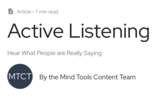
This article provides suggestions for how to improve your active listening skills -- and that you could use with your students.
- Subject:
- Professional Learning
- Material Type:
- Reading
- Author:
- MindTools
- Date Added:
- 06/08/2023

This article provides suggestions for how to improve your active listening skills -- and that you could use with your students.

This website provides class discussion strategies grouped by higher-prep, low-prep, and ongoing strategies.

Facilitating student-to-student discussion provides students an opportunity to deliberate essential questions facing their community. This is an authentic practice to build and practice content knowledge, civic skills, and dispositions.

In this activity, students will record a list of things they already know about hummingbirds and a list of things they would like to learn about hummingbirds. Then they will conduct research to find answers to their questions. Using their new knowledge, each student will make a hummingbird out of art supplies. Finally, using their hummingbirds as props, the students will play charades to test each other in their knowledge of the ruby-throated hummingbirds. The purpose of this activity is to provide students with information on ruby-throated hummingbirds, provide students with the opportunity to conduct research on hummingbirds in topic areas that interest them, and to provide students with opportunities to share their knowledge with other students. By completing this activity, students will gain knowledge about ruby-throated hummingbirds. They will also gain experience researching a topic of their choosing related to hummingbirds and communicating those results in several different formats.

Includes suggestions for how to increase student engagement and participation during class discussions.

Provides evidence-based strategies to support students (geared towards a university audience but many of the suggestions can be adapted/used in secondary contexts).
Students will learn how to say hello in five different languages.

This article provides suggestions for teaching students presentation skills.

This article provides guidelines for teaching students to organize a presentation or speech effectively, speaking with credibility and confidence.

This article describes ways teachers can be intentional about calling on a diverse set of voices, ensuring multiple perspectives are represented in class discussion.

This article provides guidelines for teaching, modeling, and practicing the basics of effective speaking.

Provides strategies to improve the quality of discussion in online as well as in-person formats.

This website and professional texts by Jeff Zwiers offer a variety of resources (tools, research, videos, etc.) for strengthening the quality and quantity of productive academic conversations.

This article provides guidelines for teaching students skills to successfully present in front of the class including addressing stage fright, effective voice, gestures, and posture, and a downloadable and editable grading rubric.

This toolbox highlights thinking routines developed across a number of research projects at PZ. A thinking routine is a set of questions or a brief sequence of steps used to scaffold and support student thinking. PZ researchers designed thinking routines to deepen students’ thinking and to help make that thinking “visible.” Thinking routines help to reveal students’ thinking to the teacher and also help students themselves to notice and name particular “thinking moves,” making those moves more available and useful to them in other contexts.

This article focuses on the ways in which teachers can ensure that students’ speaking and listening skills are developed. It provides a review of effective classroom routines.

This video includes a video of a teacher leading a whole class discussion while reflecting on the lesson.

Strategies for developing confident speakers who can share their thoughts and learning.

“They Say / I Say” identifies the key rhetorical moves in academic writing, showing students how to frame their arguments in the larger context of what others have said and providing templates to help them make those moves. And, because these moves are central across all disciplines, the book includes chapters on writing in the sciences, writing in the social sciences, and-new to this edition-writing about literature.